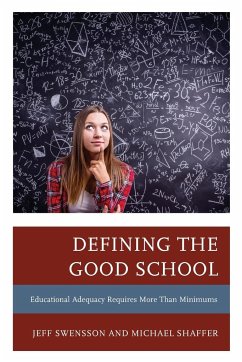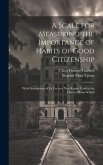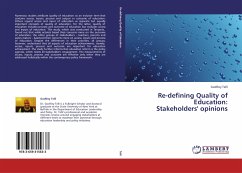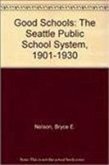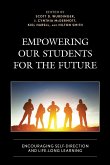Jeff Swensson, Michael Shaffer
Defining the Good School
Educational Adequacy Requires More than Minimums
Jeff Swensson, Michael Shaffer
Defining the Good School
Educational Adequacy Requires More than Minimums
- Broschiertes Buch
- Merkliste
- Auf die Merkliste
- Bewerten Bewerten
- Teilen
- Produkt teilen
- Produkterinnerung
- Produkterinnerung
Mired in an archaic purpose, American schools are inhibited by policies tethered to high minimum quality, the nation's definition of educational adequacy. This book deconstructs the barriers that obstruct the future: contemporary public education. This search uncovers the necessities for transforming educational adequacy for all US students.
Andere Kunden interessierten sich auch für
![Defining the Good School Defining the Good School]() Jeff SwenssonDefining the Good School75,99 €
Jeff SwenssonDefining the Good School75,99 €![A Scale for Measuring the Importance of Habits of Good Citizenship: With Descriptions of Its Use in a New Report Card at the Horace Mann School A Scale for Measuring the Importance of Habits of Good Citizenship: With Descriptions of Its Use in a New Report Card at the Horace Mann School]() Siegried Maia UptonA Scale for Measuring the Importance of Habits of Good Citizenship: With Descriptions of Its Use in a New Report Card at the Horace Mann School32,99 €
Siegried Maia UptonA Scale for Measuring the Importance of Habits of Good Citizenship: With Descriptions of Its Use in a New Report Card at the Horace Mann School32,99 €![Narratives on Defining Moments for Women Leaders in Higher Education Narratives on Defining Moments for Women Leaders in Higher Education]() Narratives on Defining Moments for Women Leaders in Higher Education195,99 €
Narratives on Defining Moments for Women Leaders in Higher Education195,99 €![Re-defining Quality of Education: Stakeholders' opinions Re-defining Quality of Education: Stakeholders' opinions]() Godfrey TelliRe-defining Quality of Education: Stakeholders' opinions46,99 €
Godfrey TelliRe-defining Quality of Education: Stakeholders' opinions46,99 €![Narratives on Defining Moments for Women Leaders in Higher Education Narratives on Defining Moments for Women Leaders in Higher Education]() Narratives on Defining Moments for Women Leaders in Higher Education149,99 €
Narratives on Defining Moments for Women Leaders in Higher Education149,99 €![Good Schools: The Seattle Public School System, 1901-1930 Good Schools: The Seattle Public School System, 1901-1930]() Bryce Eugene NelsonGood Schools: The Seattle Public School System, 1901-193023,99 €
Bryce Eugene NelsonGood Schools: The Seattle Public School System, 1901-193023,99 €![Empowering our Students for the Future Empowering our Students for the Future]() Empowering our Students for the Future49,99 €
Empowering our Students for the Future49,99 €-
-
-
Mired in an archaic purpose, American schools are inhibited by policies tethered to high minimum quality, the nation's definition of educational adequacy. This book deconstructs the barriers that obstruct the future: contemporary public education. This search uncovers the necessities for transforming educational adequacy for all US students.
Hinweis: Dieser Artikel kann nur an eine deutsche Lieferadresse ausgeliefert werden.
Hinweis: Dieser Artikel kann nur an eine deutsche Lieferadresse ausgeliefert werden.
Produktdetails
- Produktdetails
- Verlag: Rowman & Littlefield Publishers
- Seitenzahl: 168
- Erscheinungstermin: 21. Februar 2020
- Englisch
- Abmessung: 229mm x 152mm x 9mm
- Gewicht: 254g
- ISBN-13: 9781475856217
- ISBN-10: 1475856210
- Artikelnr.: 58296778
- Herstellerkennzeichnung
- Libri GmbH
- Europaallee 1
- 36244 Bad Hersfeld
- gpsr@libri.de
- Verlag: Rowman & Littlefield Publishers
- Seitenzahl: 168
- Erscheinungstermin: 21. Februar 2020
- Englisch
- Abmessung: 229mm x 152mm x 9mm
- Gewicht: 254g
- ISBN-13: 9781475856217
- ISBN-10: 1475856210
- Artikelnr.: 58296778
- Herstellerkennzeichnung
- Libri GmbH
- Europaallee 1
- 36244 Bad Hersfeld
- gpsr@libri.de
Jeff Swensson served in traditional public education as a teacher, assistant principal, principal, assistant superintendent, and superintendent across the Midwest for the past 45 years. He graduated from Amherst College, received his MAT from Northwestern University, and earned his PhD from Indiana University. Michael Shaffer served in schools in Kentucky, Pennsylvania, Indiana, and Iowa as an assistant principal, principal, and assistant superintendent. He graduated from Morehead State University with a BA and MA in elementary education and earned his Education Specialist and Education Doctorate in Educational Leadership from Ball State University.
Table of Contents Preface Introduction CHAPTER 1. What's the Purpose of
Public Education? The Contemporary Purpose of Education At A Loss to
Glimpse the Future The More US Education Changes, the More It Stays the
Same A Selfie Puts Education's Purpose and Educational Adequacy to the Test
A Selfie Reveals... State Authority for Public Education A Diverse Student
Population High School Graduation Funding for US Education Parents and
Caregivers The Impact of Standardized Testing Contemporary Purpose and
Standardized Testing What Do We Have Here? Implications from the Selfie A
Picture That Demands at Least a Thousand Words A Future for US Public
Education Beginning to Search with the End in Mind CHAPTER 2. True North:
The Moral Obligation of Public Education True North and Socialization
Socialization and Moral Obligation in Public Education Moral Obligation:
One Point of View Moral Obligation: Another Point of View The Troubled
History of Moral Obligation The Impact of US History Moral Obligation and
the Absence of Critical Habits of Mind The Capacity for Moral Obligation in
Public Education Leading-Out Principled Reasoning Fostering Autonomy and
Relatedness Interpretations of Moral Obligation Two Imperatives of the
Moral Obligation of Public Education Responses to these Imperatives
Students and Self-Mastery and Principled Reasoning Choices and the Future
of Moral Obligation Moral Obligation and Choices About Student Capacity
Moral Obligation and Choices About Agency in Public Education Standing in
the Way of Moral Obligation Precepts of the Moral Obligation of US Public
Education CHAPTER 3. The Eye of the Beholder: An Unavoidable Barrier This
Search and Its Barriers The Perspectives and Publics of Contemporary US
Public Education History and the Eye of the Beholder Major Perspectives
About US Public Education Free Market Schooling Choice + Mechanisms =
Competition in the Free Market In the Free Market Only the Individual Knows
Best To Create the Marketplace Only the Self-Anointed Know Best Traditional
Public Schools Two Publics in US Public Education The Public And the public
Barriers Arise Where None Should Exist Why Do These Barriers Endure? Taking
this Search Beyond the Eye of the Beholder CHAPTER 4. A Barrier Within: The
Tyranny of Either/Or The Synergy of Struggle Characteristics of the Tyranny
of Either/Or Adult-Centric Advantage Ideology Is Destiny Reform Is Ideology
Education Is Singularity The TEO Barrier: School-Attached or
School-Detached The Bricks in this Barrier Dismantling the Tyranny of
Either/Or CHAPTER 5. Confronting the Barrier of Conventional Wisdom The
Authority of Conventional Wisdom The Baleful State of Educational Adequacy
Educational Adequacy as a Social Construction Educational Adequacy as
Minimum Quality A Challenge to Educational Adequacy? See You in Court!
Deficiencies and Disparities How Educational Adequacy Becomes Conventional
Wisdom The Paradox of Educational Adequacy Educational Adequacy: A Dead End
Can Conventional Wisdom Be More than Minimums? Reconsidering Educational
Adequacy Conventional Wisdom and Linearity Mediational Influence CHAPTER 6.
The Measurement Barrier in US Public Education I-P-O and Measurement:
Standardized Testing Measurement and its Misnomers Measurement Misnamed:
Accountability Measurement Misnamed: Efficiency Naming Rights: The
Convenience of Efficiency Measurement Misnamed: Cost Abatement The Fog of
Certainty Testing Bait and Switch Just More Numbers in the Wall Students
Lost in the Fog Measurement and the Illusion Called Gap-Gazing The Weakness
of the Bricks in this Barrier The Case for Effective Evaluation Examples of
Effective Evaluation Teaching to Cognitive Expectations The End of
Measurement Inadequacy CHAPTER 7. Power and Public Education The Presence
of Power in Education The Rationale for the Future of US Public Education
The Heart of the Good Public School Power: Abuse and Potential of a Steady
State When Power Is Exclusionary The Minor Leagues: Purpose, Power, and
Education Why the Original Power of Education Is Vulnerable Amorality and
External Power The Many Effects When Wires Cross The "What," "Who," and
"Why" of Power in Education The "What" of Power in Public Education The
"Who" of Power in Public Education The "Why" of Power in Public Education
Power and "I Identify As..." Statements "I Identify As..." Statements "I
Identify As..." Statements and Stereotype Threat Avoiding the Absolutes:
Power + Corruption Uncritical Habits of Mind: A Case Example Subordination
within Contemporary Education Freedom: The Original Power of Education
Power for the Freedom of the Intentional Self CHAPTER 8. Dynamic
Instruction: Act I-Function, Evaluation, Precursors Setting the Stage for
Dynamic Instruction Learning Styles Are Instructionally Anemic Stable
Instruction Is an Unreliable Presumption Dynamic Instruction Educational
Function Educational Adequacy and Educational Function Educational Function
and Instructional Mapping Effective Evaluation Instructional Precursors Act
I: Exeunt All CHAPTER 9. Dynamic Instruction: Act II-Student Engagement
Student Engagement and Satisfactory Quality The Triumvirate of Student
Engagement Pedagogical Agency The Expectations of Pedagogical Agency
Authoritative Engagement Languaging and Student Engagement The Languaging
of a Think-Aloud The Relationship between Languaging and Memory Student
Engagement and Habits of Mind A Curtain Call for Act II The Reviews Are In:
Dynamic Instruction CHAPTER 10. Policy and Idiocy in US Public Education
The Idiocy of Contemporary Educational Policy The Idiocy of Policy: More
Linearity The Idiocy of Policy: Fantasy The Idiocy of Policy: Ignorance by
Choice The Wreck of the Good Ship Educational Policy Policy and the Siren
Song of "Reform" Locally-Sourced Policy Educational Policy: A Mutable
Dialectic A Snapshot of the Mutable Dialectic for Policy Removing Idiocy
from the Policy Menu 21st Century Educational Policy Common Ground: Policy
for the Good Public School CHAPTER 11. Recovering the "public" of US
Education The Shared Circumstance of "public" in Education The Intelligence
of Common Ground Freedom Vis-à-vis Learning A Sample Lesson: The Social
Contract Common Ground: "public" Balance and Common Ground Connection and
Common Ground Agency and Common Ground CHAPTER 12. Weaving Educational
Adequacy and the Good Public School Transforming Educational Adequacy
Commitments About Comprehensive Public Education Choices, Weaving, and
Philosophy The Good Public School: Indicators and Objectives 21CPE
Indicators 21CPE Objectives Objective #1: The Good School Is Functionally
Public Objective #2: The Good Public School Is How to Think Objective #3:
The Good Public School Fulfills Moral Obligation Objective #4: The Good
Public School Is Student-Centric Objective #5: Directing the Power of
Comprehensive Public Education CHAPTER 13. Implications from this Search
for Educational Adequacy The Second Implication The Third Implication The
Fourth Implication The Fifth Implication The Sixth Implication Learning
from the Implications of this Search Teachable Moments and Legitimacy for
21CPE CHAPTER 14. Student Futures and Comprehensive Public Education We
Have Met the Enemy and He Is Us Stasis vs. Transformation The First Tenet:
Power The Second Tenet: True North The Third Tenet: Principled Reasoning
The Fourth Tenet: Critical Habits of Mind The Fifth Tenet: Common Ground
The Benchmarks for 21CPE Promises Empower 21CPE Freedom in Comprehensive
Public Education Dealing with the "If" of 21CPE Welcome to the Good Public
School References Index
Public Education? The Contemporary Purpose of Education At A Loss to
Glimpse the Future The More US Education Changes, the More It Stays the
Same A Selfie Puts Education's Purpose and Educational Adequacy to the Test
A Selfie Reveals... State Authority for Public Education A Diverse Student
Population High School Graduation Funding for US Education Parents and
Caregivers The Impact of Standardized Testing Contemporary Purpose and
Standardized Testing What Do We Have Here? Implications from the Selfie A
Picture That Demands at Least a Thousand Words A Future for US Public
Education Beginning to Search with the End in Mind CHAPTER 2. True North:
The Moral Obligation of Public Education True North and Socialization
Socialization and Moral Obligation in Public Education Moral Obligation:
One Point of View Moral Obligation: Another Point of View The Troubled
History of Moral Obligation The Impact of US History Moral Obligation and
the Absence of Critical Habits of Mind The Capacity for Moral Obligation in
Public Education Leading-Out Principled Reasoning Fostering Autonomy and
Relatedness Interpretations of Moral Obligation Two Imperatives of the
Moral Obligation of Public Education Responses to these Imperatives
Students and Self-Mastery and Principled Reasoning Choices and the Future
of Moral Obligation Moral Obligation and Choices About Student Capacity
Moral Obligation and Choices About Agency in Public Education Standing in
the Way of Moral Obligation Precepts of the Moral Obligation of US Public
Education CHAPTER 3. The Eye of the Beholder: An Unavoidable Barrier This
Search and Its Barriers The Perspectives and Publics of Contemporary US
Public Education History and the Eye of the Beholder Major Perspectives
About US Public Education Free Market Schooling Choice + Mechanisms =
Competition in the Free Market In the Free Market Only the Individual Knows
Best To Create the Marketplace Only the Self-Anointed Know Best Traditional
Public Schools Two Publics in US Public Education The Public And the public
Barriers Arise Where None Should Exist Why Do These Barriers Endure? Taking
this Search Beyond the Eye of the Beholder CHAPTER 4. A Barrier Within: The
Tyranny of Either/Or The Synergy of Struggle Characteristics of the Tyranny
of Either/Or Adult-Centric Advantage Ideology Is Destiny Reform Is Ideology
Education Is Singularity The TEO Barrier: School-Attached or
School-Detached The Bricks in this Barrier Dismantling the Tyranny of
Either/Or CHAPTER 5. Confronting the Barrier of Conventional Wisdom The
Authority of Conventional Wisdom The Baleful State of Educational Adequacy
Educational Adequacy as a Social Construction Educational Adequacy as
Minimum Quality A Challenge to Educational Adequacy? See You in Court!
Deficiencies and Disparities How Educational Adequacy Becomes Conventional
Wisdom The Paradox of Educational Adequacy Educational Adequacy: A Dead End
Can Conventional Wisdom Be More than Minimums? Reconsidering Educational
Adequacy Conventional Wisdom and Linearity Mediational Influence CHAPTER 6.
The Measurement Barrier in US Public Education I-P-O and Measurement:
Standardized Testing Measurement and its Misnomers Measurement Misnamed:
Accountability Measurement Misnamed: Efficiency Naming Rights: The
Convenience of Efficiency Measurement Misnamed: Cost Abatement The Fog of
Certainty Testing Bait and Switch Just More Numbers in the Wall Students
Lost in the Fog Measurement and the Illusion Called Gap-Gazing The Weakness
of the Bricks in this Barrier The Case for Effective Evaluation Examples of
Effective Evaluation Teaching to Cognitive Expectations The End of
Measurement Inadequacy CHAPTER 7. Power and Public Education The Presence
of Power in Education The Rationale for the Future of US Public Education
The Heart of the Good Public School Power: Abuse and Potential of a Steady
State When Power Is Exclusionary The Minor Leagues: Purpose, Power, and
Education Why the Original Power of Education Is Vulnerable Amorality and
External Power The Many Effects When Wires Cross The "What," "Who," and
"Why" of Power in Education The "What" of Power in Public Education The
"Who" of Power in Public Education The "Why" of Power in Public Education
Power and "I Identify As..." Statements "I Identify As..." Statements "I
Identify As..." Statements and Stereotype Threat Avoiding the Absolutes:
Power + Corruption Uncritical Habits of Mind: A Case Example Subordination
within Contemporary Education Freedom: The Original Power of Education
Power for the Freedom of the Intentional Self CHAPTER 8. Dynamic
Instruction: Act I-Function, Evaluation, Precursors Setting the Stage for
Dynamic Instruction Learning Styles Are Instructionally Anemic Stable
Instruction Is an Unreliable Presumption Dynamic Instruction Educational
Function Educational Adequacy and Educational Function Educational Function
and Instructional Mapping Effective Evaluation Instructional Precursors Act
I: Exeunt All CHAPTER 9. Dynamic Instruction: Act II-Student Engagement
Student Engagement and Satisfactory Quality The Triumvirate of Student
Engagement Pedagogical Agency The Expectations of Pedagogical Agency
Authoritative Engagement Languaging and Student Engagement The Languaging
of a Think-Aloud The Relationship between Languaging and Memory Student
Engagement and Habits of Mind A Curtain Call for Act II The Reviews Are In:
Dynamic Instruction CHAPTER 10. Policy and Idiocy in US Public Education
The Idiocy of Contemporary Educational Policy The Idiocy of Policy: More
Linearity The Idiocy of Policy: Fantasy The Idiocy of Policy: Ignorance by
Choice The Wreck of the Good Ship Educational Policy Policy and the Siren
Song of "Reform" Locally-Sourced Policy Educational Policy: A Mutable
Dialectic A Snapshot of the Mutable Dialectic for Policy Removing Idiocy
from the Policy Menu 21st Century Educational Policy Common Ground: Policy
for the Good Public School CHAPTER 11. Recovering the "public" of US
Education The Shared Circumstance of "public" in Education The Intelligence
of Common Ground Freedom Vis-à-vis Learning A Sample Lesson: The Social
Contract Common Ground: "public" Balance and Common Ground Connection and
Common Ground Agency and Common Ground CHAPTER 12. Weaving Educational
Adequacy and the Good Public School Transforming Educational Adequacy
Commitments About Comprehensive Public Education Choices, Weaving, and
Philosophy The Good Public School: Indicators and Objectives 21CPE
Indicators 21CPE Objectives Objective #1: The Good School Is Functionally
Public Objective #2: The Good Public School Is How to Think Objective #3:
The Good Public School Fulfills Moral Obligation Objective #4: The Good
Public School Is Student-Centric Objective #5: Directing the Power of
Comprehensive Public Education CHAPTER 13. Implications from this Search
for Educational Adequacy The Second Implication The Third Implication The
Fourth Implication The Fifth Implication The Sixth Implication Learning
from the Implications of this Search Teachable Moments and Legitimacy for
21CPE CHAPTER 14. Student Futures and Comprehensive Public Education We
Have Met the Enemy and He Is Us Stasis vs. Transformation The First Tenet:
Power The Second Tenet: True North The Third Tenet: Principled Reasoning
The Fourth Tenet: Critical Habits of Mind The Fifth Tenet: Common Ground
The Benchmarks for 21CPE Promises Empower 21CPE Freedom in Comprehensive
Public Education Dealing with the "If" of 21CPE Welcome to the Good Public
School References Index
Table of Contents Preface Introduction CHAPTER 1. What's the Purpose of
Public Education? The Contemporary Purpose of Education At A Loss to
Glimpse the Future The More US Education Changes, the More It Stays the
Same A Selfie Puts Education's Purpose and Educational Adequacy to the Test
A Selfie Reveals... State Authority for Public Education A Diverse Student
Population High School Graduation Funding for US Education Parents and
Caregivers The Impact of Standardized Testing Contemporary Purpose and
Standardized Testing What Do We Have Here? Implications from the Selfie A
Picture That Demands at Least a Thousand Words A Future for US Public
Education Beginning to Search with the End in Mind CHAPTER 2. True North:
The Moral Obligation of Public Education True North and Socialization
Socialization and Moral Obligation in Public Education Moral Obligation:
One Point of View Moral Obligation: Another Point of View The Troubled
History of Moral Obligation The Impact of US History Moral Obligation and
the Absence of Critical Habits of Mind The Capacity for Moral Obligation in
Public Education Leading-Out Principled Reasoning Fostering Autonomy and
Relatedness Interpretations of Moral Obligation Two Imperatives of the
Moral Obligation of Public Education Responses to these Imperatives
Students and Self-Mastery and Principled Reasoning Choices and the Future
of Moral Obligation Moral Obligation and Choices About Student Capacity
Moral Obligation and Choices About Agency in Public Education Standing in
the Way of Moral Obligation Precepts of the Moral Obligation of US Public
Education CHAPTER 3. The Eye of the Beholder: An Unavoidable Barrier This
Search and Its Barriers The Perspectives and Publics of Contemporary US
Public Education History and the Eye of the Beholder Major Perspectives
About US Public Education Free Market Schooling Choice + Mechanisms =
Competition in the Free Market In the Free Market Only the Individual Knows
Best To Create the Marketplace Only the Self-Anointed Know Best Traditional
Public Schools Two Publics in US Public Education The Public And the public
Barriers Arise Where None Should Exist Why Do These Barriers Endure? Taking
this Search Beyond the Eye of the Beholder CHAPTER 4. A Barrier Within: The
Tyranny of Either/Or The Synergy of Struggle Characteristics of the Tyranny
of Either/Or Adult-Centric Advantage Ideology Is Destiny Reform Is Ideology
Education Is Singularity The TEO Barrier: School-Attached or
School-Detached The Bricks in this Barrier Dismantling the Tyranny of
Either/Or CHAPTER 5. Confronting the Barrier of Conventional Wisdom The
Authority of Conventional Wisdom The Baleful State of Educational Adequacy
Educational Adequacy as a Social Construction Educational Adequacy as
Minimum Quality A Challenge to Educational Adequacy? See You in Court!
Deficiencies and Disparities How Educational Adequacy Becomes Conventional
Wisdom The Paradox of Educational Adequacy Educational Adequacy: A Dead End
Can Conventional Wisdom Be More than Minimums? Reconsidering Educational
Adequacy Conventional Wisdom and Linearity Mediational Influence CHAPTER 6.
The Measurement Barrier in US Public Education I-P-O and Measurement:
Standardized Testing Measurement and its Misnomers Measurement Misnamed:
Accountability Measurement Misnamed: Efficiency Naming Rights: The
Convenience of Efficiency Measurement Misnamed: Cost Abatement The Fog of
Certainty Testing Bait and Switch Just More Numbers in the Wall Students
Lost in the Fog Measurement and the Illusion Called Gap-Gazing The Weakness
of the Bricks in this Barrier The Case for Effective Evaluation Examples of
Effective Evaluation Teaching to Cognitive Expectations The End of
Measurement Inadequacy CHAPTER 7. Power and Public Education The Presence
of Power in Education The Rationale for the Future of US Public Education
The Heart of the Good Public School Power: Abuse and Potential of a Steady
State When Power Is Exclusionary The Minor Leagues: Purpose, Power, and
Education Why the Original Power of Education Is Vulnerable Amorality and
External Power The Many Effects When Wires Cross The "What," "Who," and
"Why" of Power in Education The "What" of Power in Public Education The
"Who" of Power in Public Education The "Why" of Power in Public Education
Power and "I Identify As..." Statements "I Identify As..." Statements "I
Identify As..." Statements and Stereotype Threat Avoiding the Absolutes:
Power + Corruption Uncritical Habits of Mind: A Case Example Subordination
within Contemporary Education Freedom: The Original Power of Education
Power for the Freedom of the Intentional Self CHAPTER 8. Dynamic
Instruction: Act I-Function, Evaluation, Precursors Setting the Stage for
Dynamic Instruction Learning Styles Are Instructionally Anemic Stable
Instruction Is an Unreliable Presumption Dynamic Instruction Educational
Function Educational Adequacy and Educational Function Educational Function
and Instructional Mapping Effective Evaluation Instructional Precursors Act
I: Exeunt All CHAPTER 9. Dynamic Instruction: Act II-Student Engagement
Student Engagement and Satisfactory Quality The Triumvirate of Student
Engagement Pedagogical Agency The Expectations of Pedagogical Agency
Authoritative Engagement Languaging and Student Engagement The Languaging
of a Think-Aloud The Relationship between Languaging and Memory Student
Engagement and Habits of Mind A Curtain Call for Act II The Reviews Are In:
Dynamic Instruction CHAPTER 10. Policy and Idiocy in US Public Education
The Idiocy of Contemporary Educational Policy The Idiocy of Policy: More
Linearity The Idiocy of Policy: Fantasy The Idiocy of Policy: Ignorance by
Choice The Wreck of the Good Ship Educational Policy Policy and the Siren
Song of "Reform" Locally-Sourced Policy Educational Policy: A Mutable
Dialectic A Snapshot of the Mutable Dialectic for Policy Removing Idiocy
from the Policy Menu 21st Century Educational Policy Common Ground: Policy
for the Good Public School CHAPTER 11. Recovering the "public" of US
Education The Shared Circumstance of "public" in Education The Intelligence
of Common Ground Freedom Vis-à-vis Learning A Sample Lesson: The Social
Contract Common Ground: "public" Balance and Common Ground Connection and
Common Ground Agency and Common Ground CHAPTER 12. Weaving Educational
Adequacy and the Good Public School Transforming Educational Adequacy
Commitments About Comprehensive Public Education Choices, Weaving, and
Philosophy The Good Public School: Indicators and Objectives 21CPE
Indicators 21CPE Objectives Objective #1: The Good School Is Functionally
Public Objective #2: The Good Public School Is How to Think Objective #3:
The Good Public School Fulfills Moral Obligation Objective #4: The Good
Public School Is Student-Centric Objective #5: Directing the Power of
Comprehensive Public Education CHAPTER 13. Implications from this Search
for Educational Adequacy The Second Implication The Third Implication The
Fourth Implication The Fifth Implication The Sixth Implication Learning
from the Implications of this Search Teachable Moments and Legitimacy for
21CPE CHAPTER 14. Student Futures and Comprehensive Public Education We
Have Met the Enemy and He Is Us Stasis vs. Transformation The First Tenet:
Power The Second Tenet: True North The Third Tenet: Principled Reasoning
The Fourth Tenet: Critical Habits of Mind The Fifth Tenet: Common Ground
The Benchmarks for 21CPE Promises Empower 21CPE Freedom in Comprehensive
Public Education Dealing with the "If" of 21CPE Welcome to the Good Public
School References Index
Public Education? The Contemporary Purpose of Education At A Loss to
Glimpse the Future The More US Education Changes, the More It Stays the
Same A Selfie Puts Education's Purpose and Educational Adequacy to the Test
A Selfie Reveals... State Authority for Public Education A Diverse Student
Population High School Graduation Funding for US Education Parents and
Caregivers The Impact of Standardized Testing Contemporary Purpose and
Standardized Testing What Do We Have Here? Implications from the Selfie A
Picture That Demands at Least a Thousand Words A Future for US Public
Education Beginning to Search with the End in Mind CHAPTER 2. True North:
The Moral Obligation of Public Education True North and Socialization
Socialization and Moral Obligation in Public Education Moral Obligation:
One Point of View Moral Obligation: Another Point of View The Troubled
History of Moral Obligation The Impact of US History Moral Obligation and
the Absence of Critical Habits of Mind The Capacity for Moral Obligation in
Public Education Leading-Out Principled Reasoning Fostering Autonomy and
Relatedness Interpretations of Moral Obligation Two Imperatives of the
Moral Obligation of Public Education Responses to these Imperatives
Students and Self-Mastery and Principled Reasoning Choices and the Future
of Moral Obligation Moral Obligation and Choices About Student Capacity
Moral Obligation and Choices About Agency in Public Education Standing in
the Way of Moral Obligation Precepts of the Moral Obligation of US Public
Education CHAPTER 3. The Eye of the Beholder: An Unavoidable Barrier This
Search and Its Barriers The Perspectives and Publics of Contemporary US
Public Education History and the Eye of the Beholder Major Perspectives
About US Public Education Free Market Schooling Choice + Mechanisms =
Competition in the Free Market In the Free Market Only the Individual Knows
Best To Create the Marketplace Only the Self-Anointed Know Best Traditional
Public Schools Two Publics in US Public Education The Public And the public
Barriers Arise Where None Should Exist Why Do These Barriers Endure? Taking
this Search Beyond the Eye of the Beholder CHAPTER 4. A Barrier Within: The
Tyranny of Either/Or The Synergy of Struggle Characteristics of the Tyranny
of Either/Or Adult-Centric Advantage Ideology Is Destiny Reform Is Ideology
Education Is Singularity The TEO Barrier: School-Attached or
School-Detached The Bricks in this Barrier Dismantling the Tyranny of
Either/Or CHAPTER 5. Confronting the Barrier of Conventional Wisdom The
Authority of Conventional Wisdom The Baleful State of Educational Adequacy
Educational Adequacy as a Social Construction Educational Adequacy as
Minimum Quality A Challenge to Educational Adequacy? See You in Court!
Deficiencies and Disparities How Educational Adequacy Becomes Conventional
Wisdom The Paradox of Educational Adequacy Educational Adequacy: A Dead End
Can Conventional Wisdom Be More than Minimums? Reconsidering Educational
Adequacy Conventional Wisdom and Linearity Mediational Influence CHAPTER 6.
The Measurement Barrier in US Public Education I-P-O and Measurement:
Standardized Testing Measurement and its Misnomers Measurement Misnamed:
Accountability Measurement Misnamed: Efficiency Naming Rights: The
Convenience of Efficiency Measurement Misnamed: Cost Abatement The Fog of
Certainty Testing Bait and Switch Just More Numbers in the Wall Students
Lost in the Fog Measurement and the Illusion Called Gap-Gazing The Weakness
of the Bricks in this Barrier The Case for Effective Evaluation Examples of
Effective Evaluation Teaching to Cognitive Expectations The End of
Measurement Inadequacy CHAPTER 7. Power and Public Education The Presence
of Power in Education The Rationale for the Future of US Public Education
The Heart of the Good Public School Power: Abuse and Potential of a Steady
State When Power Is Exclusionary The Minor Leagues: Purpose, Power, and
Education Why the Original Power of Education Is Vulnerable Amorality and
External Power The Many Effects When Wires Cross The "What," "Who," and
"Why" of Power in Education The "What" of Power in Public Education The
"Who" of Power in Public Education The "Why" of Power in Public Education
Power and "I Identify As..." Statements "I Identify As..." Statements "I
Identify As..." Statements and Stereotype Threat Avoiding the Absolutes:
Power + Corruption Uncritical Habits of Mind: A Case Example Subordination
within Contemporary Education Freedom: The Original Power of Education
Power for the Freedom of the Intentional Self CHAPTER 8. Dynamic
Instruction: Act I-Function, Evaluation, Precursors Setting the Stage for
Dynamic Instruction Learning Styles Are Instructionally Anemic Stable
Instruction Is an Unreliable Presumption Dynamic Instruction Educational
Function Educational Adequacy and Educational Function Educational Function
and Instructional Mapping Effective Evaluation Instructional Precursors Act
I: Exeunt All CHAPTER 9. Dynamic Instruction: Act II-Student Engagement
Student Engagement and Satisfactory Quality The Triumvirate of Student
Engagement Pedagogical Agency The Expectations of Pedagogical Agency
Authoritative Engagement Languaging and Student Engagement The Languaging
of a Think-Aloud The Relationship between Languaging and Memory Student
Engagement and Habits of Mind A Curtain Call for Act II The Reviews Are In:
Dynamic Instruction CHAPTER 10. Policy and Idiocy in US Public Education
The Idiocy of Contemporary Educational Policy The Idiocy of Policy: More
Linearity The Idiocy of Policy: Fantasy The Idiocy of Policy: Ignorance by
Choice The Wreck of the Good Ship Educational Policy Policy and the Siren
Song of "Reform" Locally-Sourced Policy Educational Policy: A Mutable
Dialectic A Snapshot of the Mutable Dialectic for Policy Removing Idiocy
from the Policy Menu 21st Century Educational Policy Common Ground: Policy
for the Good Public School CHAPTER 11. Recovering the "public" of US
Education The Shared Circumstance of "public" in Education The Intelligence
of Common Ground Freedom Vis-à-vis Learning A Sample Lesson: The Social
Contract Common Ground: "public" Balance and Common Ground Connection and
Common Ground Agency and Common Ground CHAPTER 12. Weaving Educational
Adequacy and the Good Public School Transforming Educational Adequacy
Commitments About Comprehensive Public Education Choices, Weaving, and
Philosophy The Good Public School: Indicators and Objectives 21CPE
Indicators 21CPE Objectives Objective #1: The Good School Is Functionally
Public Objective #2: The Good Public School Is How to Think Objective #3:
The Good Public School Fulfills Moral Obligation Objective #4: The Good
Public School Is Student-Centric Objective #5: Directing the Power of
Comprehensive Public Education CHAPTER 13. Implications from this Search
for Educational Adequacy The Second Implication The Third Implication The
Fourth Implication The Fifth Implication The Sixth Implication Learning
from the Implications of this Search Teachable Moments and Legitimacy for
21CPE CHAPTER 14. Student Futures and Comprehensive Public Education We
Have Met the Enemy and He Is Us Stasis vs. Transformation The First Tenet:
Power The Second Tenet: True North The Third Tenet: Principled Reasoning
The Fourth Tenet: Critical Habits of Mind The Fifth Tenet: Common Ground
The Benchmarks for 21CPE Promises Empower 21CPE Freedom in Comprehensive
Public Education Dealing with the "If" of 21CPE Welcome to the Good Public
School References Index

